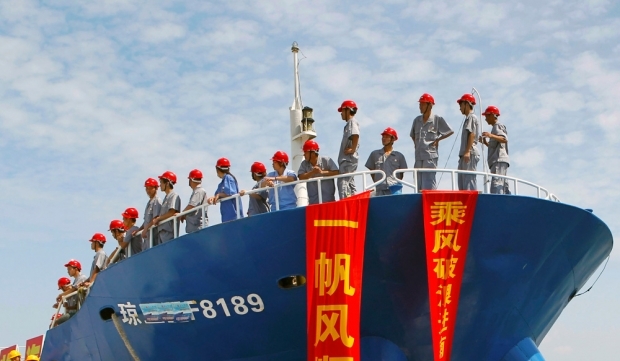In 1890, an undistinguished U.S. Navy captain published a book that would influence generations of strategists. Alfred Thayer Mahan’s The Influence of Sea Power Upon History, 1660–1783 posited that great nations need potent, blue-water navies backed by far-flung naval bases to project power around the globe. His work was so influential that Kaiser Wilhelm II of Germany pledged to learn it by heart as he sought to triumph over the dominant power of his day, Britain and its Royal Navy. When Mahan died nearly one hundred years ago, just after the outbreak of World War I, he was widely blamed for being the lead theorist for an arms race that led to the catastrophic conflict.
It may be a little too pat, but it’s probably no coincidence that Mahan is enjoying newfound fame in another rising power: China. Mahan’s books have been widely reprinted in China, including one that features a fold-out map of the Pacific showing U.S. naval facilities in the region. The lesson for China is plain—at least in the Pacific region, it must emulate America’s naval strength if it wants to become a great power.
Viewpoint
03.06.14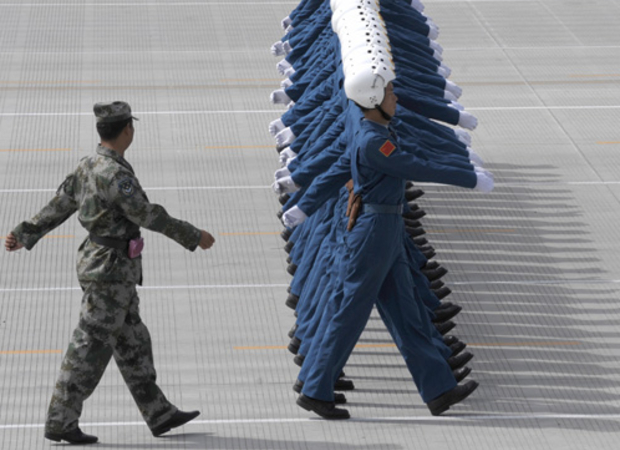
Can America Win in a New Era of Competition with China?
The popularity of Mahan’s book is one of the fascinating threads in Geoff Dyer’s The Contest of the Century. The title might sound a bit like a reality show, while the subtitle (The New Era of Competition with China—and How America Can Win) has the tone of a self-help book for a fading superpower. But ignore these examples of editorial overreach; Dyer’s book is stimulating, erudite, and deeply researched, perfectly timed to explain the unfolding conflicts in East Asia. He focuses on maritime affairs as a clue to China’s intentions, which he bluntly states as: “Forget their bland rhetoric: China’s leaders think very much in geopolitical terms and would like to gradually erode the bases of American power.”
This runs counter to the two dominant ways of looking at China. One is that China is so obsessed with domestic issues that it has little real interest in getting involved abroad. Its corollary is that Beijing is too insecure about its hold on power at home to think seriously about challenging the U.S. But Dyer—a former Beijing bureau chief for the Financial Times—points out that China already is involved abroad, while “domestic insecurity is feeding, not inhibiting, the desire to stand tall overseas.”
Dyer is hardly an alarmist. His main point isn’t that China and the U.S. are headed for a military conflict. With both sides possessing nuclear weapons, a war isn’t likely. Instead, his broader point is that China is shifting from a country that accepts existing rules to one that wants to make them. Dyer points out a great irony in this: China’s rise has been made possible because of the global trading system and alliances that Washington created after World War II. The U.S. hasn’t prevented China from buying resources or exporting its goods; on the contrary, its navy has created a calming effect that makes China’s vast seaborne trade possible, while American consumers have bought its products.
* * *
America’s dominance is eroding primarily because China’s economic rise enables it to assert long-standing territorial claims, and it is doing so by changing international norms. This is clearest in how China views the Law of the Sea. This 1982 UN treaty defines territorial waters as extending twelve nautical miles from a country’s coast. It also gives countries a two-hundred-mile “exclusive economic zone.” The two are not the same: territorial waters can be entered only with a country’s permission; the economic zone is for economic exploitation but foreign ships, including warships, can pass through it freely.
What China is doing now is to redefine the economic zone into a kind of territorial air and sea zone—hence the series of conflicts between U.S. and Chinese forces. In 2009, for example, a U.S. surveillance ship towing a barge full of intelligence equipment was patrolling seventy miles off the coast of China when it was confronted by a flotilla of Chinese ships. They deployed planks to obstruct the U.S. ship. When the U.S. ship turned, sailors on the Chinese ships used poles to smash the equipment on the U.S. barge. After completing their mission, the crew of one Chinese boat dropped their pants and waved their rear ends in the direction of the Americans.
Most recently, in December, China’s new aircraft carrier, the Liaoning, got into a naval dispute in its first significant voyage. Traveling south to the contested waters of the South China Sea, it was shadowed at a distance by a U.S. cruiser. When the U.S. ship got too close—estimates are that it was several dozen miles away—a Chinese escort ship executed a dangerous maneuver, cutting directly in front of the U.S. ship and forcing it to take evasive action. The move was defended as necessary to protect the carrier. The carrier was under no threat, but carriers are the ultimate Mahan prestige project—capital ships meant to project power around the globe.
This near clash came shortly after China redefined the airspace over parts of the Pacific, creating an Air Defense Identification Zone that covered islands controlled by Japan. This was the latest in a series of recent moves to assert sovereignty over the islands, which in Japan are called the Senkaku and in China the Diaoyu.
Individually, it’s easy to explain away these events, or even to see them as laughable. (Mooning a ship? Throwing planks in the water? They hardly constitute the Battle of the Nile.) But taken together they do show China’s desire to expand its reach. They also become more significant when China’s territorial claims are taken into account. China claims the entire South China Sea—which includes almost all the waters between Vietnam to the west, Malaysia to the south, and the Philippines to the east. These waters contain contested islands, and if China were to obtain control over them, as it wishes, and then redefine its economic zone around each one into quasi-territorial waters, then its territorial waters would include some of the most important shipping lanes in the world.
If this sounds far-fetched, consider that Chinese law already treats these waters as domestically controlled. In January, for example, China announced new fishing regulations that cover most of the South China Sea. The new measures require foreign fishing ships to obtain permission from China before operating in the waters. Tellingly, the law says the waters should be policed by China’s coast guard, not its navy. This can be seen as reducing tensions, but also that China considers the waters to be so domestic that it doesn’t need to involve its navy.
Such laws beg the question of who will follow them. It’s hard to imagine Vietnamese fishing boats faxing requests to fish in waters they have trawled for years. But in a way, this isn’t the point. The new rules should instead be seen as Beijing methodically laying the groundwork for control of these waters, part of a very long-term strategy.
* * *
Dyer makes this point most effectively by comparing events today with those in U.S. history. In 1823, Washington announced what came to be known as the Monroe Doctrine, stating that any further efforts by European powers to colonize or interfere with states in North or South America would be viewed as an act of aggression and require U.S. intervention. At first, this was mere bluster. The United States had no significant navy, and Britain continued to act as it saw fit, especially in the Caribbean, a body of water that’s as close and crucial to the United States as the South China Sea is to China. As late as 1890, the year Mahan’s book was published, the U.S. Navy was still the butt of jokes.
Books
04.01.14
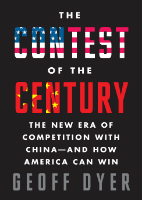
The Contest of the Century
But the 1823 declaration was a marker. By the end of that century, the United States developed a navy that could enforce this claim. Eventually, the Caribbean came to be dominated by the United States. Britain’s influence there faded. So too, perhaps, with China and the United States.
I was reminded of this long-term horizon when reading a New York Times piece from last year on the fate of Ayungin, a submerged reef that is part of the Spratly Islands. Lying 105 nautical miles from the Philippines, the reef is part of its economic zone and is claimed by Manila as its territory. But over the years, Chinese ships have began to patrol the reef, and essentially have swallowed it up, much as they did Mischief Reef in the 1990s, eventually turning it into a military base.
Worried that this would be repeated, the Philippines sank an old ship on top of Ayungin. It now houses eight Filipino soldiers, who hold out in Kurtzian conditions. Meanwhile, Chinese ships surround the rocky outcropping, interdicting supply ships. The men are supplied only sporadically when Filipino fishing vessels slip in, but for all purposes the territory and surrounding seas have been lost to China. The article showed the disarray in the Philippines, and how China patiently waits for its chances.1
China’s neighbors have begun pushing back. Most dramatically, Philippines President Benigno S. Aquino III said in February that his country’s situation was analogous to Czechoslovakia’s on the eve of World War II, when it was forced to surrender parts of its territory. Military spending is rising in several Asian countries, most notably Japan, while India has begun testing a new ballistic missile that could hit China.
China’s methodical acquisition of overseas bases is another lesson drawn from the Mahan playbook of great powerdom. Mahan called on the United States to acquire bases so its fleet could refuel. It was during this time, the late nineteenth century, that America made its big push to incorporate Hawaii, and pushed even further into the Pacific by acquiring the Midway archipelago—named because it lies roughly midway between North America and Asia. Soon after, it obtained the Guantánamo Bay naval base to protect the Panama Canal. Likewise China’s apparent moves to build ports and deepwater facilities in countries that are somewhat friendly to Beijing, especially Burma, Pakistan, and Sri Lanka. Some seem to be mainly commercial projects, but Dyer argues that one day they could become bases for the Chinese navy. At the very least, the intention appears to exist.
A subtler point is that both countries’ expansion came about as a result of broader changes in economics, and in people’s mindsets. Mahan’s book was so influential because it caught the spirit of the times. In another era or country, it might not have made a splash. Instead, people like the financier J.P. Morgan thought it so important that he donated money to help get it published.
In China, too, one senses that the military buildup and projection are the result of forces not always part of a government plan. The port in Burma, for example, is being pushed by a Chinese oil company. It argues that it would be safer to send Middle Eastern oil to Burma and then by pipeline to China, rather than by ship through the Straits of Malacca and directly to China. And then there is nascent public opinion in China, which is often louder and more bellicose than official pronouncements. In other words, things like bases don’t always come about because of grand strategy cooked up by geniuses in Beijing or Washington but because of longer-term forces.
* * *
What I also found intriguing about Dyer’s book was his ability to humanize the Chinese military. We meet Liu Huaqing, the former commander of the Chinese fleet. Already in 1987, Liu said, “Without an aircraft carrier, I will die with my eyelids open.” Days before Liu died in 2011, the Liaoning started its sea trials. Time and again Dyer shows the depth of passion and long memory of Chinese planners and politicians. They remind us that China’s aspirations aren’t new; it’s the ability to realize them that is novel.2
China’s aspirations could be ignored as unrealistic in the near-to-medium term; after all, the United States has by far the world’s biggest military.3 Matching it would take many more decades. But even if this is China’s long-term plan—and it’s not clear that it is—China’s geopolitical rise matters right now. That’s because China isn’t trying to match the United States base for base, carrier for carrier around the world.
“Instead,” Dyer writes, “its military buildup is designed to gradually change the calculations of American commanders, to dissuade them from considering military operations anywhere near China’s coast, and to push them slowly farther out into the Pacific.” To change this strategic balance, it need only engage in “access denial,” using enough hardware to make it costly for the United States to get involved.
In some ways, it already feels that we have arrived at this tipping point. I visited Taiwan during its first democratic presidential election, in 1996, something China opposed because it implied that Taiwan was independent enough from the mainland to choose its own leaders. To show its anger, Beijing fired ballistic missiles that landed just inside Taiwan’s territorial waters. The crisis ended only when Washington sent two carrier battle groups to Taiwan. One wonders if the United States would do the same today; consider that on its maiden voyage in December and January, the Liaoning passed through the Straits of Taiwan. Would the U.S. risk a possible clash such as nearly happened in December?
Expensive military equipment like carrier groups raises deeper questions about a country’s underlying economic strengths. The United States spends almost as much on its military as the rest of the world combined. Its position seems unassailable. But while China is a distant second, its military spending is growing at a double-digit rate—indeed, in early March, the government announced that military spending would increase by 12.2 percent—and it is now firmly established as the only country capable of rivaling the U.S. in military expenditures. It also is unencumbered by what Dyer sees as wounds the United States has recently inflicted on itself:
While the US has been fighting a losing battle in Afghanistan for over a decade and poured more than a trillion dollars into the debacle in Iraq, China has been carefully conducting the biggest military expansion in the world.
One wonders how much longer the United States can continue to support such an enormous military. Dyer is a Financial Times journalist and has something to say about each country’s economic fundamentals, but not as much as one might like. He is mostly—and correctly, I believe—dismissive of the argument that because China owns so much U.S. debt it can influence Washington’s policy. Indeed, as Dyer points out, China is trapped by all the treasury bonds it owns—like a bank that has lent almost all its money to one borrower, it is as tied to the debtor as the other way around.
* * *
But I would have liked to have read a bit more about how each country’s economic prospects will influence this growing rivalry. For that, I learned much from Stephen Roach’s book Unbalanced: The Codependency of America and China. Roach is a senior fellow at Yale University’s school of management and a former chief economist at Morgan Stanley, the investment bank, where he was one of the most influential writers on the Asian economy in the 1990s and 2000s. His book is a lucid and accessible primer on each country’s strengths, weaknesses, and prospects, highly recommendable to specialists and lay people alike.
Books
03.19.14
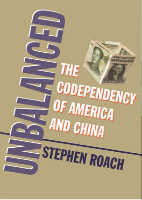
Unbalanced
Roach’s thesis is that both countries are unhealthily reliant on each other—he uses the analogy of an overly dependent couple, locked in an unstable condition of mutual need and hate. But he makes the case that the United States is in a worse long-term position than China. China exports too much, and relies too much on capital investment for growth. But its leaders clearly know this and are embarking on structural reforms that could slowly change its habits and allow for more domestically driven demand and innovation. The United States, according to Roach, “doesn’t seem to get it”; its political elite is primarily trying to resurrect the consumer-dependent growth of past decades.
The guts of Roach’s book are profiles of two pairs of policymakers: Alan Greenspan and Zhu Rongji, and Ben Bernanke and Wen Jiabao. In the first matchup, Roach says Zhu clearly wins. Greenspan helped to create one bubble after the other, while Zhu reformed China’s economy. Zhu did set China down the road of overreliance on exports, but he also undertook far-reaching reforms.
Of the second pairing, Roach is more ambivalent. Both men were good at analyzing their countries’ problems but less effective in engineering changes. Still, Roach sees Wen as setting the stage for the current round of reforms thanks to his forthright criticisms of China’s economic system. Bernanke, by contrast, has not effectively pushed for change, in Roach’s view. The comparisons might not be entirely fair because Bernanke and Greenspan were central bankers, not premiers of a one-party state, and thus didn’t have as much power as their Chinese counterparts. But Roach effectively uses them as symbols of their countries’ reform history.
Roach is not a defeatist. He says the United States has great strengths and could start exporting more—for example, to China, if China really does begin to consume more. But to do that, the United States must strengthen its hollowed-out industrial base and improve its institutions. Yet as he points out, the United States is losing its competitive advantage, slipping steadily in international comparisons. Shockingly to many Americans, the main culprits are basic requirements such as the country’s infrastructure, political system, health care, and primary education. This leads Roach to conclude that the historian Paul Kennedy has it right: the United States is in decline due to “the imbalance between America’s unparalleled projection of its vast military power and the erosion of its domestic economic base.”
This isn’t to say that there aren’t severe dysfunctionalities in China. The key underlying issue is of course political reform. This term is widely used in China, but primarily means bureaucratic streamlining or improved administrative responsiveness to citizen complaints.
* * *
One could argue that human rights don’t matter to China’s rise—that these are domestic issues that won’t affect expansion abroad. And yet China’s narrow political system is clearly one reason for its neighbors’ suspicions. If the government continues to lock up moderates then many abroad will wonder if China is the sort of country that can make a long-term stable friend.
The most recent case was the conviction of rights activist Xu Zhiyong. In late January, he was sentenced to four years in prison on charges of “gathering a crowd to disturb public order,” stemming from his work to organize the New Citizens Movement. That group, entirely peaceful in its activities, aimed for reforms to the existing system to combat corruption and promote a fairer education system, especially for disadvantaged rural children. The two demands are largely in line with priorities of Communist Party leader Xi Jinping, and Xu was widely seen in dissident circles as a moderate. Harshness like this at home won’t prevent China from cutting resource deals—China has money, and these goods are for sale—but it will make it hard for any developed (and, by extension, democratic) country to treat China like a true long-term partner.
This theme is picked up with gusto in David Shambaugh’s China Goes Global: The Partial Power. Shambaugh is one of the most influential analysts of China–U.S. relations. His book shows the flip side of China’s military rise: its inability to use its new power to influence the world. It’s a wide-ranging, impressive work, reflecting Shambaugh’s decades of research and far-ranging contacts in Chinese policymaking circles. His book makes use of interviews not only in China but in Europe and other countries, affording him a 360-degree view of China’s rise.
Books
03.28.13
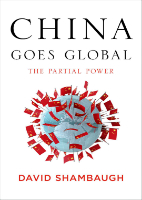
China Goes Global
What Shambaugh makes clear is that for all the bluster, China actually accomplishes little diplomatically. Except for events directly affecting its territory, it stays on the sidelines of most international conflicts, never shaping outcomes. Instead, its main foreign policy tool seems to be the ritualized state visit by foreign dignitaries.
In one of my favorite sections of the book, Shambaugh describes how these visits play out. The foreigner always visits the same few places: Tiananmen Square, the Great Hall of the People, the Diaoyutai Guest House, and the Zhongnanhai leadership compound. At one of the latter two locations a bizarre meeting takes place. The Chinese leader is kept out of sight in a room behind a door. He is always standing. The foreigner is then let in from an antechamber. This forces the foreigner to walk up to the Chinese leader. The foreign guest arrives on the Chinese leader’s right side and the two stand facing the cameras. Then they shake hands, still facing the cameras.
The foreigner’s location on the right is important because the foreigner has to reach awkwardly across his body to shake hands with the leader, while the Chinese leader only has to extend his right hand slightly. “As a result, the Chinese leader always appears relaxed and confident, whereas the foreigner often seems physically uncomfortable.” These theatrics, of course, are for domestic consumption. But they also reflect a telling lack of substance in Chinese diplomacy and an overreliance on showmanship. They might also say something about the need for an aircraft carrier and to defend it with theatrical gestures—a desire to measure up and surpass one’s opponents. In some ways such concerns to make a visible effect recall the great early-twentieth-century Chinese author Lu Xun and his berating of Chinese for “spiritual victories.”
Another example is China’s love of slogans. At home, it regularly bombards citizens with slogans like “harmonious society” or “China dream.” Abroad, it has used equally empty slogans over the past fifteen years, throwing out terms such as “new international order,” “new security concept,” “China’s peaceful development road,” “China’s peaceful rise,” “strategic partnership,” “peaceful development,” and “harmonious world.” Foreigners are expected to acknowledge these slogans, a practice known as biaotai, or “to declare where one stands.” But as Shambaugh points out, this is simply parroting slogans back to China, not a meaningful discussion.
Digging deeper into these practices, Shambaugh sees a crisis of national identity. He has a telling interview with Men Honghua of the Central Party School. Men said China had great, universal values but they were destroyed in the Cultural Revolution:
We have lost our values—we do not have any common values at all. There is a vacuum of values in China. Nor do we have an ideology.
* * *
The deep structure of Chinese politics and society is also captured in China Story Yearbook 2013: Civilising China, a compilation of essays edited by the Australian Sinologist Geremie Barmé and the Beijing-based writer Jeremy Goldkorn. This is the second year that they have published this valuable look at the past year, which is available free as a download. The Yearbook has a summary of recent events with short, punchy essays by up-and-coming writers such as Leta Hong Fincher on women, Benjamin Penny on social role models, and Sebastian Veg on nationalism. Goldkorn also has written a valuable chapter on the government’s efforts to “civilize” (i.e., control) the Internet.
Barmé’s chapter on the Communist Party’s values is especially noteworthy. He points out the Party’s central contradiction. On the one hand, it explicitly rejects what it calls “universal values,” declaring that Chinese socialism has served China well:
Such triumphalism masks the fact that there is an abiding clash of cultures within the Chinese Communist Party itself. Its strict materialist worldview precludes any endorsement of abstract human worth and universal value. But, rhetorically at least, it recognizes the potentially positive role of values that, like Marxism itself, first evolved in the West.
After reading these books I was persuaded by Dyer that the U.S. faces a serious challenge. I also thought that Shambaugh’s discussion on soft power was especially convincing. Part of being a hegemon is having an attractive culture that others seek to emulate, and China doesn’t seem to have this (despite a fascinating history and traditional culture).
But I kept thinking back to Roach’s book. Being clever and having soft power are fine but they have to be underpinned by serious economic policy and a sustainable fiscal system. More importantly, they have to be backed by a populace and political elite that believe in its system. If the United States continues to disregard these basics, China may not need a Mahan-like program of building warships; its rise may simply be by default.
- “A Game of Shark and Minnow,” The New York Times Magazine, October 27, 2013. The interactive online version is highly recommended.↩
- One criticism at this point concerns Dyer’s selective endnotes. Dyer reports that the Pentagon estimates China will have two more carriers operational by next year—highly implausible, but uncheckable because he has no citations.↩
- This is a point made in a very worthwhile upcoming volume, Strategic Reassurance and Resolve: U.S.-China Relations in the Twenty-First Century by James Steinberg and Michael E. O’Hanlon (Princeton University Press, 2014). This book carefully dissects the main problems discussed by Dyer. Most striking to me was that while America’s military budget is dominant, China could have a budget of roughly $300 billion by the end of the decade, versus $500 billion to $600 billion for the United States.↩




